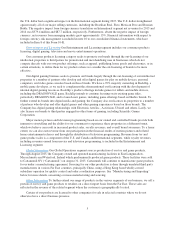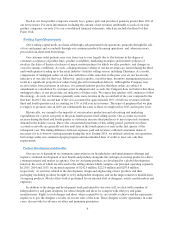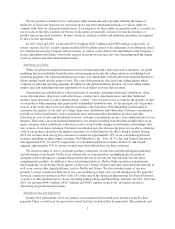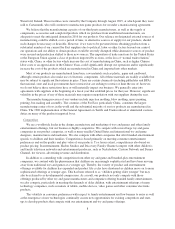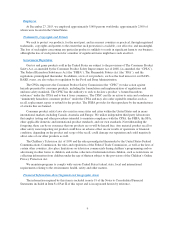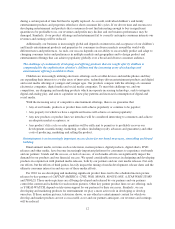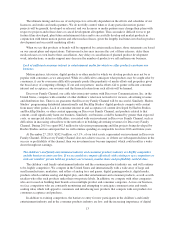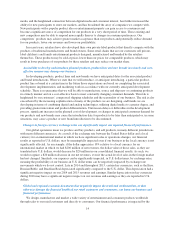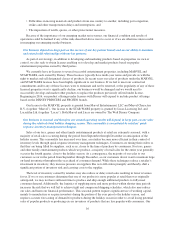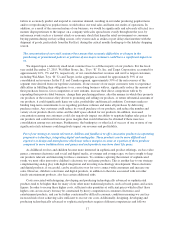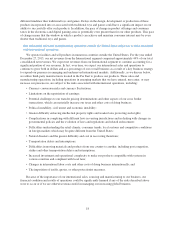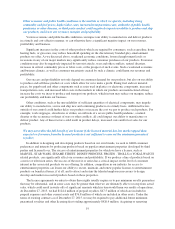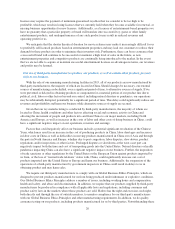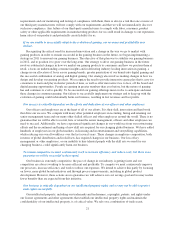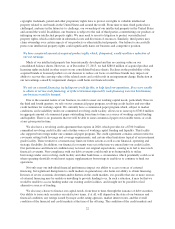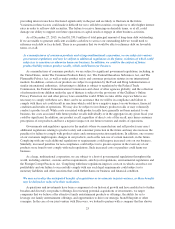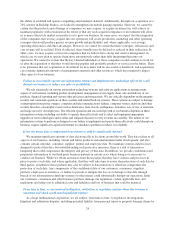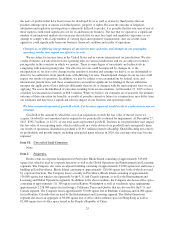Hasbro 2015 Annual Report Download - page 26
Download and view the complete annual report
Please find page 26 of the 2015 Hasbro annual report below. You can navigate through the pages in the report by either clicking on the pages listed below, or by using the keyword search tool below to find specific information within the annual report.level of discretionary consumer spending in the markets in which we operate. Recessions, credit crises and other
economic downturns, or disruptions in credit markets, in the United States and in other markets in which our
products are marketed and sold can result in lower levels of economic activity, lower employment levels, less
consumer disposable income, and lower consumer confidence. Similarly, reductions in the value of key assets
held by consumers, such as their homes or stock market investments, can lower consumer confidence and
consumer spending power. Any of these factors can reduce the amount which consumers spend on the purchase
of our products. This in turn can reduce our revenues and harm our financial performance and profitability.
In addition to experiencing potentially lower revenues from our products during times of economic
difficulty, in an effort to maintain sales during such times we may need to reduce the price of our products,
increase our promotional spending and/or sales allowances, or take other steps to encourage retailer and
consumer purchase of our products. Those steps may lower our net revenues or increase our costs, thereby
decreasing our operating margins and lowering our profitability.
Challenging market conditions in certain developed economies, such as in Australia and certain Western
European countries, make it more difficult for us to succeed.
Our future success in developed economies is impacted by market conditions. For example, a European
sovereign debt crisis or other significant negative shock to European markets could lead to a recession in Europe,
which may negatively impact consumers and in turn, sales of our products in the European markets. Similar
negative events impacting the market in the United States and other developed economies may harm our
business.
Many categories within the toy, game and family entertainment industries in certain developed economies,
such as Australia and certain Western European countries, have not grown, or in some cases have even declined,
in certain recent years. In addition, many current economic predictions suggest developed economies may grow
only modestly, if at all, in the next several years. We have substantial business in developed economies, and
these markets represent a majority of our current product sales. It is more difficult for us to grow, or even
maintain, our business when the overall market in certain of the major countries we serve is not growing or is
declining. To succeed in a market that is stable or declining, we must maintain or gain market share from our
competitors, which is more difficult than growing in an expanding market. As long as economic conditions in the
developed economies remain difficult, this will be an additional challenge for the Company.
An increasing portion of our business is expected to come from emerging markets, and growing business in
emerging markets presents additional challenges.
We expect an increasing portion of our net revenues to come from emerging markets in the future, including
Eastern Europe, Latin America and Asia. In 2015 revenues in emerging markets constituted approximately 14%
of our net revenues, up from only 6% of our net revenues in 2010. Over time, we expect our emerging market net
revenues to continue to grow both in absolute terms and as a percentage of our overall business as one of our key
business strategies is to increase our presence in emerging and underserved international markets. Operating in
an increasing number of markets, each with its own unique consumer preferences and business climates, presents
additional challenges that we must meet. In addition to the need to successfully anticipate and serve different
global consumer preferences and interests, sales and operations in emerging markets that we have entered, may
enter, or may increase our presence in, are subject to other risks associated with international operations,
including:
• Complications in complying with different laws in varying jurisdictions and in dealing with changes in
governmental policies and the evolution of laws and regulations that impact our product offerings and
related enforcement;
• Potential challenges to our transfer pricing determinations and other aspects of our cross border
transactions;
• Difficulties understanding the retail climate, consumer trends, local customs and competitive conditions
in foreign markets which may be quite different from the United States;
15


